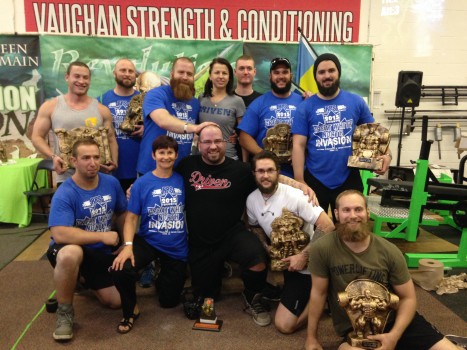
Recently, on Facebook and other parts of the web, I have seen a lot of people suffer from burn out and, consequently, dive into a deep depression about their meet results. I've even seen some people post about having such extreme anxiety going into a meet that they aren't able to function, and they end up bombing out of the meet before it even starts. Unfortunately, it sounds as if they are suffering from something that is entirely preventable—they suffer because they have no goals and had no plan. Powerlifting is much like life. If one fails to plan, then it is the same as planning to fail. Without a plan there is no direction, and with no direction you can have no end goal. In order to maximize your abilities as an athlete, you must have concrete goals of how you are going to get to your chosen destination. A long time ago, in a land far away, a 21-year-old version of myself went to a seminar with two really big dudes—Dave Tate and Jim Wendler. At this seminar, Dave said something that I will never forget...Well, I may have forgotten the exact words he used, but it went something like,
“Being without goals as an athlete is like trying to get to the Dallas Cowboys stadium with a map of Detroit. You can go as fast and as hard as you want, and you can be as driven to reach your destination as possible, but you’re not going to get to the Cowboys stadium unless it's just dumb luck.”
So, we must have a plan. Well, plans are made up of steps, and those steps are made up of two types of goals: process goals and product goals. The first step to goal setting is to determine what your ultimate goal is—say, to win a national championship. After that, you must set up smaller milestone goals to keep you in focus. A goal such as a national championship or chasing a Pro or Elite total is tough to stay motivated for since it may take at least two years (or three or four) to accomplish. That is why you need smaller goals! These smaller goals help to keep you motivated and to stay on the right track. This end goal (e.g., a national championship) is the product goal, and you can have multiple product goals along the way.
For instance, let's say my ultimate goal is to squat 1,000 pounds, but my current squat is only 450 pounds. A good way to do this is to break this up into smaller goals. In four months, my goal is to squat 500 pounds. Six months after that my goals is 550 pounds, and six months after that it is 600 pounds. Then, when the progress slows, you alter the timeline or your goal numbers (dropping your increments from 50 pounds to 20 pounds, for example, and extending the timelines from six months to a year). All the while, however, you are working from small goal to small goal in an effort to reach your end product—a 1,000-pound squat. Now, besides breaking up your goal into increments along the way, there needs to be some process goals. What are process goals you may ask?
A process goal is something to focus on that is not part of the main goal, but it is something that will help you get there. Process goals can be anything, and they can vary from lifter to lifter and meet to meet. For instance, let's say that I'm stuck at the 600-pound squat, and I notice on film that my knees are shooting out past my toes when I start to ascend on my squat. That lets me know that my hamstrings are weak, and this is probably what is holding my squat back. Therefore, to counter this, I come up with a measurable goal to help remedy this. Maybe it's something like increasing my RDL with perfect form by 40-pounds, or increasing the number of perfect glute ham raises I can do in a row. Either way, whatever is helping you in the process of achieving the main goal is a process goal. Maybe it's not really a strength issue at all. Perhaps it's learning the form in a new squat suit. You can measure your goals using film in order to see what's wrong and how to correct it. If your knees are collapsing inward due to the pull of the suit, then make your goal be to force your knees out against the suit. Process goals can go beyond the physical as well. For many people, it's not the physicality that is holding them back—it is something mental. Process goals could involve going over visualization of a successful lift 15 times per week, or going over affirmations three times a day. Since there is a number of how many times per week you are doing them, this helps it become quantifiable. Now, with goal setting, we need to make sure that they are SMART goals. Goals that are specific, measurable, attainable, relevant, and time-bound.
The goal must be specific.
To say that "I want to squat a house" isn't specific. For one, there are all sizes of houses. You can be squatting a one-room log cabin and call it good since it's a house, but in reality, you want to squat a mansion. On the other hand, saying that "my goal is to squat 1,000 pounds" is very specific. One thousand pounds is 1,000 pounds any way you look at it. Improving squat form is also too vague. It needs to be a specific part of it. Are you flaring your knees out? Are you sitting back? The goal must be measurable. There must be a way to quantify that goal. Some may argue that technique improvements aren't measurable, but I would disagree. There is a great amount of free software and apps that allow you to video and analyze your form. If you had a 10* collapse before (as measured on dartfish), and now it's only 3*, then that is an improvement.
The goal must be attainable.
To say that I want to be 6-foot-4 is a great goal, but it is not attainable since I don't have any more growth plates. The fantastic thing about powerlifting, however, is that nearly all goals are attainable in this sport. It's just a matter of how much you are willing to put into it, how much pain you are willing to endure, and how much you are willing to sacrifice. The genetically-gifted athlete may be able to achieve his goals more quickly, but nearly all long-term goals are attainable. There is an old saying that went, “Shoot for the moon. Even if you don't reach your goal,you will land among the stars.” For of all, that means that the goal wasn't attainable, and you're setting yourself up for depression when you don't achieve it. Secondly, that saying is absolute bullshit. Anyone who has had astronomy 101 knows that the stars are much farther away than the moon. The moon is the closest thing to Earth in the entire galaxy. The sun is a star and is much, much further away. Besides that, if you were next to the sun, your ass would burn into one crispy critter in no time flat. So, don't set goals like that (the long-term is different).
The goal must be relevant.
For someone who is powerlifiting and who decides that he wants to have a great half court shot and an elite marathon time...wait what? Why the hell would he want to spend time on that? It takes time away from the goal of powerlifting. Besides, long distance running sucks. But hopefully you see the point. The goals should all relate back to one another in some respect. Some goals may be for bench, some may be for squat, and some may be for the deadlift, but they are all events in a powerlifitng meet.
The goal must be time-bound.
There needs to be a start date and an end date. If you have a goal that has no start date, then it allows you to keep putting it off. And guess what? There is no perfect time to start—there is no sixth Tuesday in February. Having a start date forces you to start it when you do. On the other hand, the end date for powerlifting is great because of the nature of the sport. Your end date is usually a meet, so those are taken care of, but you need to make sure that you start the goal as well. I think there needs to be one more aspect of SMART goals that needs to be understood. Goals are written on paper...they are not written in stone. Goals are not something that should weigh you down and crush you if you don't succeed. They are a way of measuring where you are and where you are going. They provide direction. If you miss your goal for some reason, it's okay. The goal was written in paper, and the date is easily changeable. Now, this isn't to say that it's okay to be soft and not work hard since you can always change your goal. If you're not achieving your goal because you were stupid and didn't do things in-line with your process goals, then that's just a missed goal on your part and you need to work again and do it harder. Sometimes in life, things just happen. Jobs are lost, loved ones pass on, and extraneous circumstances occur, and we have to miss training sessions to take care of it. Now, many people have product goals—their end goals, but few set up the process goals. Now, why is having process goals important? Because they give you something else to achieve and to focus on. Even if you don't quite achieve your main goal, if you achieved four process goals along the way, you will still feel successful (because you are), and the process goals should always support the main goal. Going back to the initial road map example:
The product goals are the major roadways that you take, but few times in life will you be on all major roads. You'll usually have to take some side streets and turns to get where you need to go. The side streets are the process goals. Using process goals and product goals in conjunction will help you be confident on meet day. You have your product goal to achieve because you have achieved your process goals in training for the upcoming competition. You can be more confident because you know that you've done everything possible to become more competent, and you will able to achieve your best on that day.










![IMG_0446[1]](https://www.elitefts.com/wp/wp-content/uploads/2015/06/IMG_04461.jpg)


